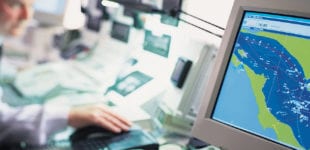August 19, 2019
About 70 percent of the Earth is covered by water, but we know only 5 percent of the ocean’s depths, leaving 95 percent completely unexplored, according to the National Oceanic and Atmospheric Association. Deep-sea travel has proven to be a solid training ground for space exploration. What can the oceans and autonomous underwater vehicles tell us, both about the world we live in and the worlds we want to explore?
We asked IEEE member Hari Vishnu, editor-in-chief of Earthzine, science outreach publication of the IEEE Oceanic Engineering Society, to address these questions. Dr. Vishnu also is a research fellow at the Acoustic Research Laboratory, National University of Singapore. His current research interests lie in underwater acoustic modeling, deep-sea resource exploration and more.
Q: What robotic technologies are used in oceanic exploration? How do the challenges compare to those encountered by rovers used in lunar and planetary exploration?
A: Robots used for exploring the oceans include autonomous underwater vehicles (AUVs) that operate without a human operator, remotely operated vehicles (ROVs) that operate with human control and autonomous surface vehicles. Developing and operating robots underwater involves many tough challenges reminiscent of those required to operate the lunar or Mars rovers. In both cases, the robots must operate with limited, often non-robust communication capabilities. They must operate in harsh environments which are often less-known beforehand, and must be equipped to deal with contingencies arising in such environments. The terrain is also often not well-understood prior to the robot’s missions in both these cases. Perhaps these are the reasons why we still know less about the ocean floor as compared to the surface of Mars or the Moon.
NASA often sends its astronauts on long underwater missions to train them for contingencies that can occur during complex missions to the Moon or Mars. These are called NASA extreme environment mission operations. “Isolating crew members at the bottom of the ocean simulates life and work for astronauts in microgravity environments like the International Space Station, or in spacecraft that will travel to asteroids and planets in the future,” Examples of underwater missions undertaken for training for deep-space missions are detailed here and here. So the parallels between the two realms couldn’t be clearer.
Q: How does your current research protect the environment and our natural capital?
A: My research is on underwater sound signal processing and machine learning, as well as the application of these techniques in biological and man-made sonars, deep-sea exploration and survey of marine wildlife.
Sound is a good long-distance carrier of information underwater. In my work, I use sound to understand different aspects of the oceans and its wildlife. I try to shed light (or sound!) on how dolphins use acoustics to sense their surroundings accurately, sometimes even better than man-made systems can. I am exploring the use of sound to monitor the melt-rate of ice in the Arctic, thus aiding in our understanding of this region. I also study the detection of marine mammals in Singapore waters via the sound they produce. These can form crucial components in wildlife conservation and survey, and to understand the health of our environment.
Q: How are you using machine learning and artificial intelligence in your work? What scientific advances have you made in relying on this technology?
A: I use machine learning for two applications. First, to sift through several hundreds of hours of long-term acoustic recordings made in Singapore waters, and pick up short sound snippets where dolphins are vocalizing. This can help us quantify the local dolphin population as an indicator of the marine environmental health, as well as to understand their visiting patterns and behavior better.
I also use machine learning to assess deep-sea resources in the Pacific Ocean and understand their relation to the local environment. By tapping into the power of machine learning, we are able to assess these resources using a smaller amount of open-domain data than required by conventional techniques. In the process, we also better understood the formation of these resources.
Q: What do you see for the future of underwater robotics and its impact on space and underwater exploration?
A: The use of robots in exploration of realms spanning sea-to-space is increasing everyday. And we need people, more than ever, to take up careers in this field – as scientists, technologists, engineers and more. Robotics competitions are very effective in getting students interested in hands-on robotics, and inspiring them to take up careers in such fields. For the past six years, I have been helping to conduct the Singapore AUV challenge, the biggest underwater robotics competition in Asia – a summary video of our 2019 event can be found here. Apart from classroom education, activities like this one are crucial for inspiring the next generation to come up with landmark achievements such as the Lunar landing of 1969 or exploration of the Mariana Trench.





 The Impact of Technology in 2025
The Impact of Technology in 2025 Quantum and AI: Safeguards or Threats to Cybersecurity?
Quantum and AI: Safeguards or Threats to Cybersecurity? Why AI Can't Live Without Us
Why AI Can't Live Without Us Bits, Bytes, Buildings and Bridges: Digital-Driven Infrastructure
Bits, Bytes, Buildings and Bridges: Digital-Driven Infrastructure Impact of Technology in 2024
Impact of Technology in 2024 Emerging AI Cybersecurity Challenges and Solutions
Emerging AI Cybersecurity Challenges and Solutions The Skies are Unlimited
The Skies are Unlimited Smart Cities 2030: How Tech is Reshaping Urbanscapes
Smart Cities 2030: How Tech is Reshaping Urbanscapes Impact of Technology 2023
Impact of Technology 2023 Cybersecurity for Life-Changing Innovations
Cybersecurity for Life-Changing Innovations Smarter Wearables Healthier Life
Smarter Wearables Healthier Life Infrastructure In Motion
Infrastructure In Motion The Impact of Tech in 2022 and Beyond
The Impact of Tech in 2022 and Beyond Cybersecurity, Technology and Protecting Our World
Cybersecurity, Technology and Protecting Our World How Technology Helps us Understand Our Health and Wellness
How Technology Helps us Understand Our Health and Wellness The Resilience of Humanity
The Resilience of Humanity Harnessing and Sustaining our Natural Resources
Harnessing and Sustaining our Natural Resources Creating Healthy Spaces Through Technology
Creating Healthy Spaces Through Technology Exceptional Infrastructure Challenges, Technology and Humanity
Exceptional Infrastructure Challenges, Technology and Humanity The Global Impact of IEEE's 802 Standards
The Global Impact of IEEE's 802 Standards Scenes of our Cyber Lives: The Security Threats and Technology Solutions Protecting Us
Scenes of our Cyber Lives: The Security Threats and Technology Solutions Protecting Us How Millennial Parents are Embracing Health and Wellness Technologies for Their Generation Alpha Kids
How Millennial Parents are Embracing Health and Wellness Technologies for Their Generation Alpha Kids Space Exploration, Technology and Our Lives
Space Exploration, Technology and Our Lives Global Innovation and the Environment
Global Innovation and the Environment How Technology, Privacy and Security are Changing Each Other (And Us)
How Technology, Privacy and Security are Changing Each Other (And Us) Find us in booth 31506, LVCC South Hall 3 and experience the Technology Moon Walk
Find us in booth 31506, LVCC South Hall 3 and experience the Technology Moon Walk Virtual and Mixed Reality
Virtual and Mixed Reality How Robots are Improving our Health
How Robots are Improving our Health IEEE Experts and the Robots They are Teaching
IEEE Experts and the Robots They are Teaching See how millennial parents around the world see AI impacting the lives of their tech-infused offspring
See how millennial parents around the world see AI impacting the lives of their tech-infused offspring Take the journey from farm to table and learn how IoT will help us reach the rising demand for food production
Take the journey from farm to table and learn how IoT will help us reach the rising demand for food production Watch technical experts discuss the latest cyber threats
Watch technical experts discuss the latest cyber threats Explore how researchers, teachers, explorers, healthcare and medical professionals use immersive technologies
Explore how researchers, teachers, explorers, healthcare and medical professionals use immersive technologies Follow the timeline to see how Generation AI will be impacted by technology
Follow the timeline to see how Generation AI will be impacted by technology Learn how your IoT data can be used by experiencing a day in a connected life
Learn how your IoT data can be used by experiencing a day in a connected life Listen to technical experts discuss the biggest security threats today
Listen to technical experts discuss the biggest security threats today See how tech has influenced and evolved with the Games
See how tech has influenced and evolved with the Games Enter our virtual home to explore the IoT (Internet of Things) technologies
Enter our virtual home to explore the IoT (Internet of Things) technologies Explore an interactive map showcasing exciting innovations in robotics
Explore an interactive map showcasing exciting innovations in robotics Interactively explore A.I. in recent Hollywood movies
Interactively explore A.I. in recent Hollywood movies Get immersed in technologies that will improve patients' lives
Get immersed in technologies that will improve patients' lives